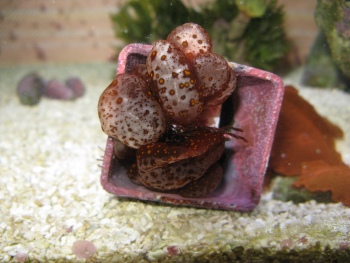
By Bob Goemans

Not Reef Tank Suitable
Not Suitable for Fish-Only Tank
Range: Indian Ocean, Western, Central and Eastern Pacific, and the Mediterranean, with it arriving mostly in the aquarium trade from the Philippines on live rock and various coral specimens. It is also found in Hawaii, Maldives, America Samoa, Marshall Islands, and California waters.
Natural Environment: Encrusts various types of substrate, whether living or not, and appears to do well in nutrient poor waters with little light intensity and under a wide range of temperatures.
Aquarium Suitability: Even though there is about 48 species in this genus, with this alga often called 'Red Valonia' by many in the hobby, this is the most devastating form.
In the wild and aquaria it forms interconnected low growing bladders, which are filled with a syrup-like fluid. Growths, beginning with small red wine-colored bubbles, 2 - 10 mm in height, spread a base that erupts with new short-stemmed bubbles/bladders, with older bubbles often reaching heights of almost .5 inch (1 cm). As its base spreads, it encroaches on living organisms, crowding them out and opening new substrate areas for its own growth.
When the syrup filled bubbles open, the liquid slowly flows into the surrounding water no doubt spreading new spores to other areas in the aquarium. In fact, once the bladder surface forms small spots, it is said to be ready for sexual reproduction, which seems from my sad experience with this species to occur within a couple of months of it forming new bladders. Nothing in the aquarium, including live corals, live rock or even aquariums side panels will escape these growths.
Unfortunately, the spread of new growths seem to also occur in systems with zero phosphates and near zero nitrates, therefore, its spread cannot be eliminated by maintaining high quality water parameters. Furthermore, I have not seen any of the well known algae consumers, such as various type urchins, crabs, sea hares, and well known herbivorous fish species even dent this alga species! And it even grows in shady areas! I have a suspicion that iodine additions may accelerate its growth or the alga itself naturally contains a high level of iodine resulting in a bad taste to grazers, but at this time it's only a theory.
Since there are no known predators of this invasive species, and I've tried several different small tangs, emerald crabs, sea hares, and urchins to no avail, under no circumstances should it be allowed to continue anywhere the aquarium! Unfortunately this means when first seen, whatever its on must be removed from the aquarium and wiped clean, with the area of removal flushed clean before replacement in the aquarium. And its far better to do this when first seen, as this species tends to spread quite quickly, as I've recently had one aquarium almost ruined in two years because of this alga! And only removal by hand, and continued removal of various items in the aquarium have allowed the system to continue.
Potential Control Species: None!
Taxonomy:
Kingdom: Plantae
Phylum: Rhodophyta
Class: Florideophyceae
Order: Rhodymeniales
Family: Rhodymeniaceae
Genus: Botryocladia
